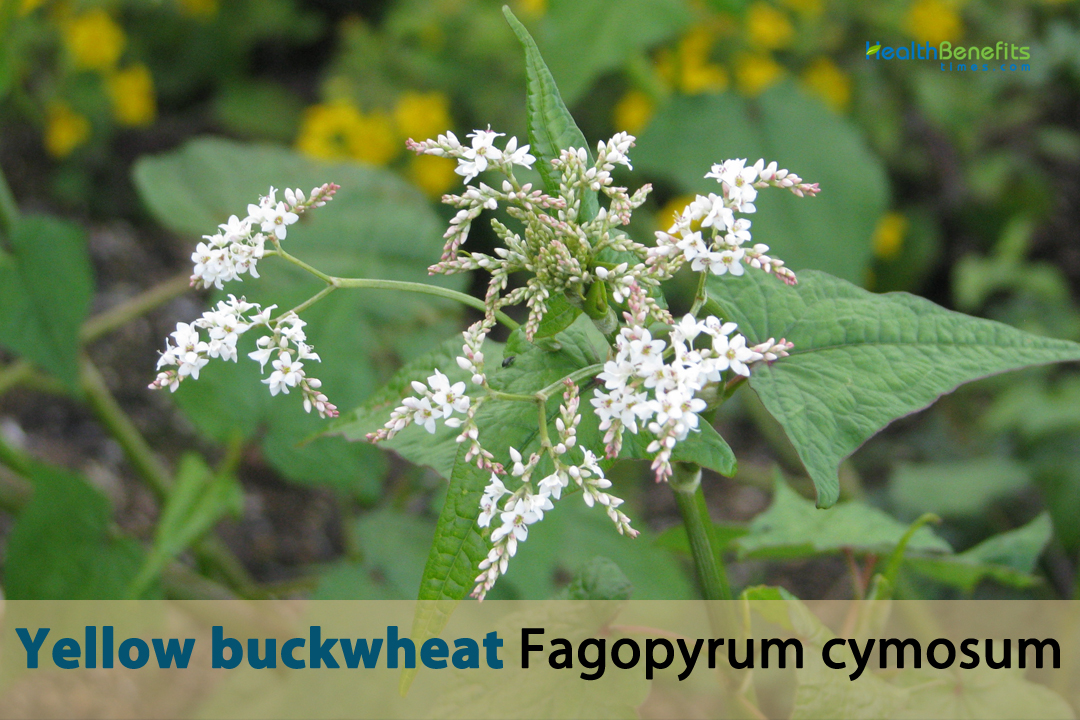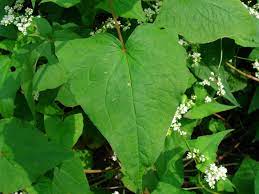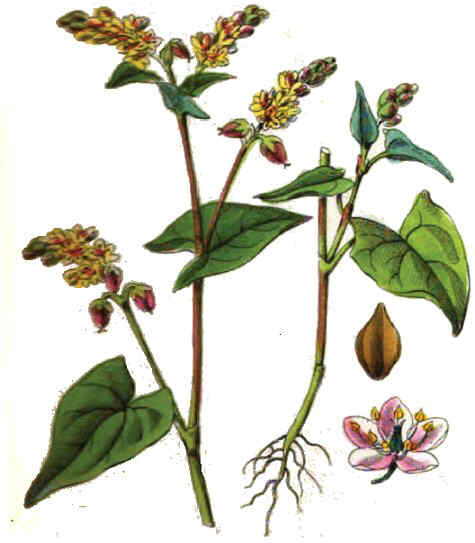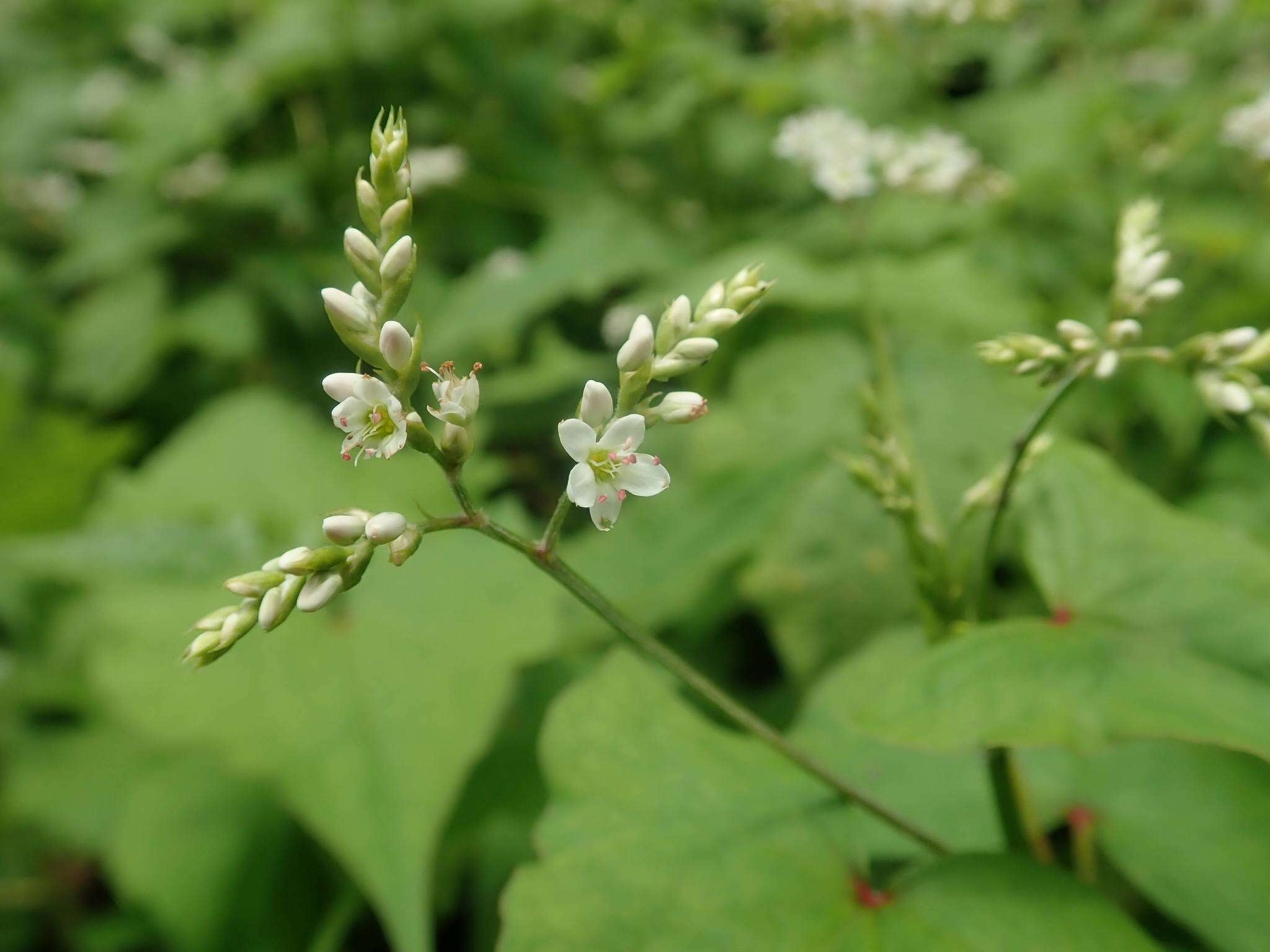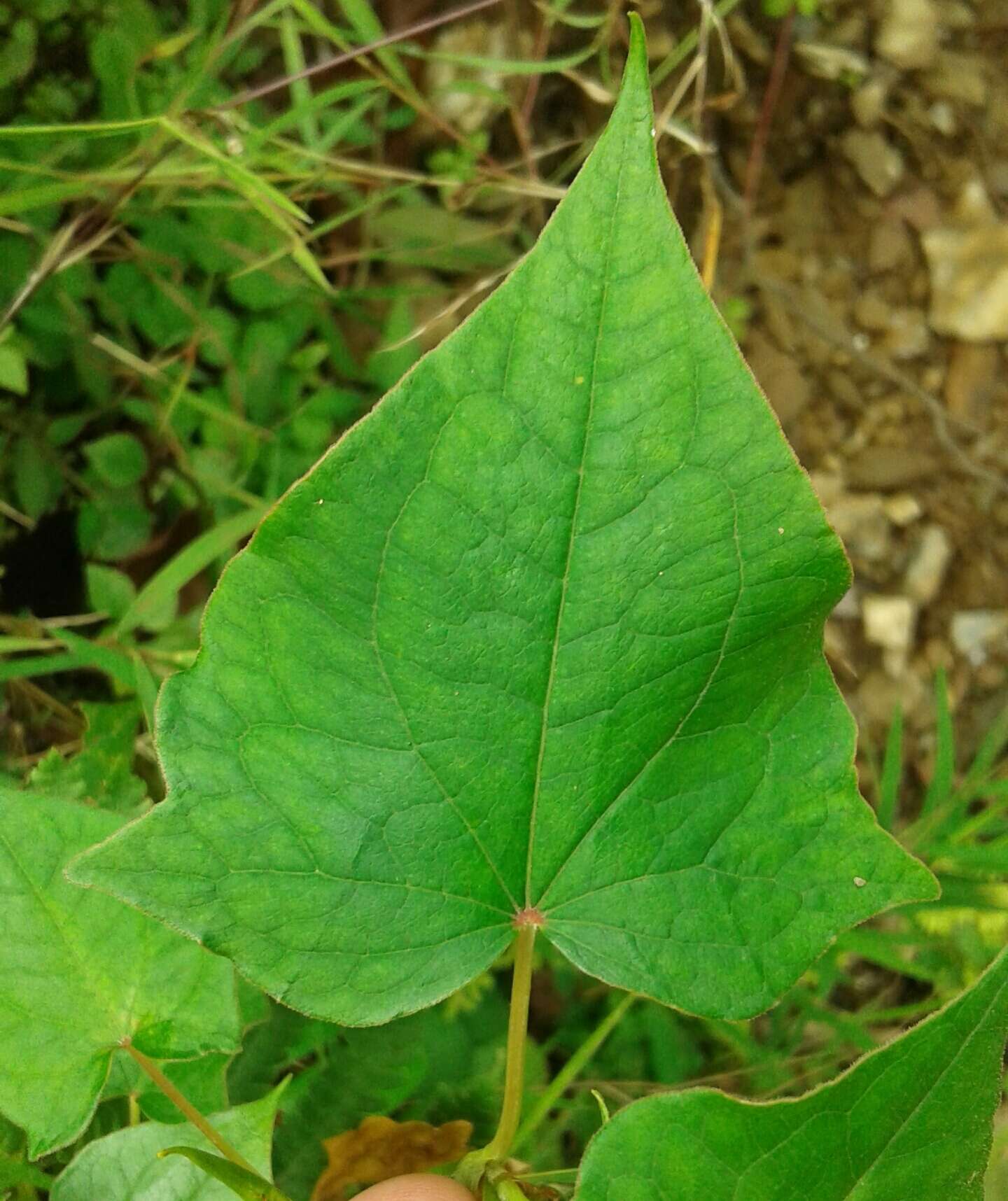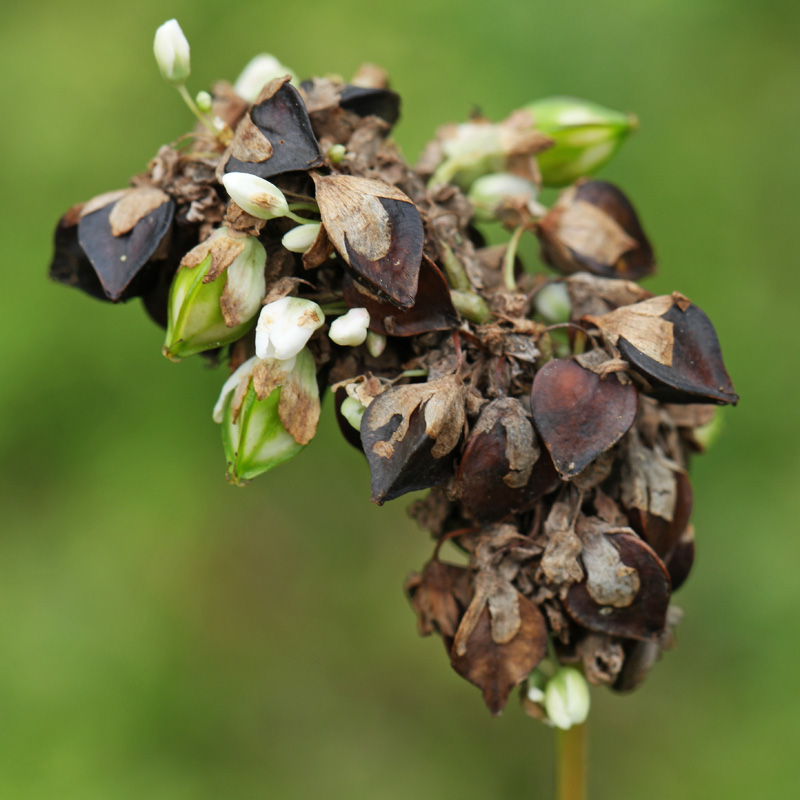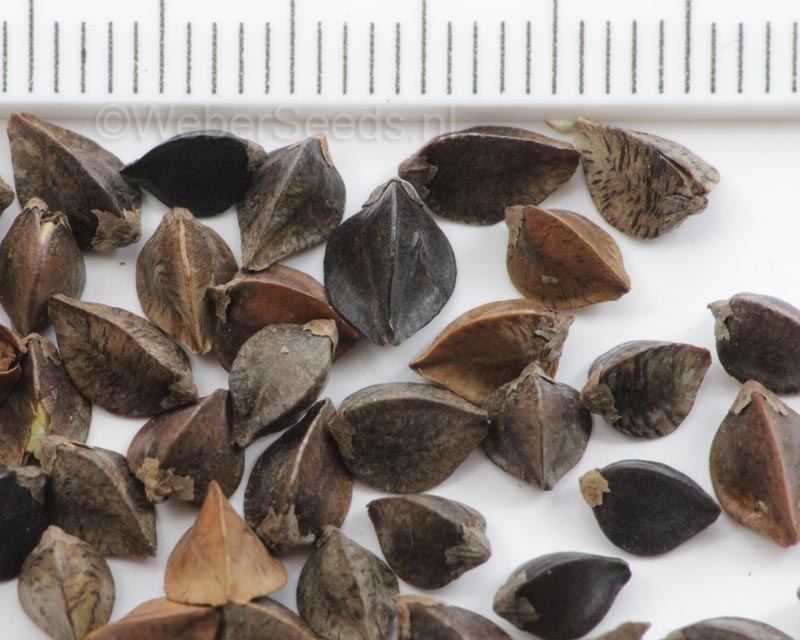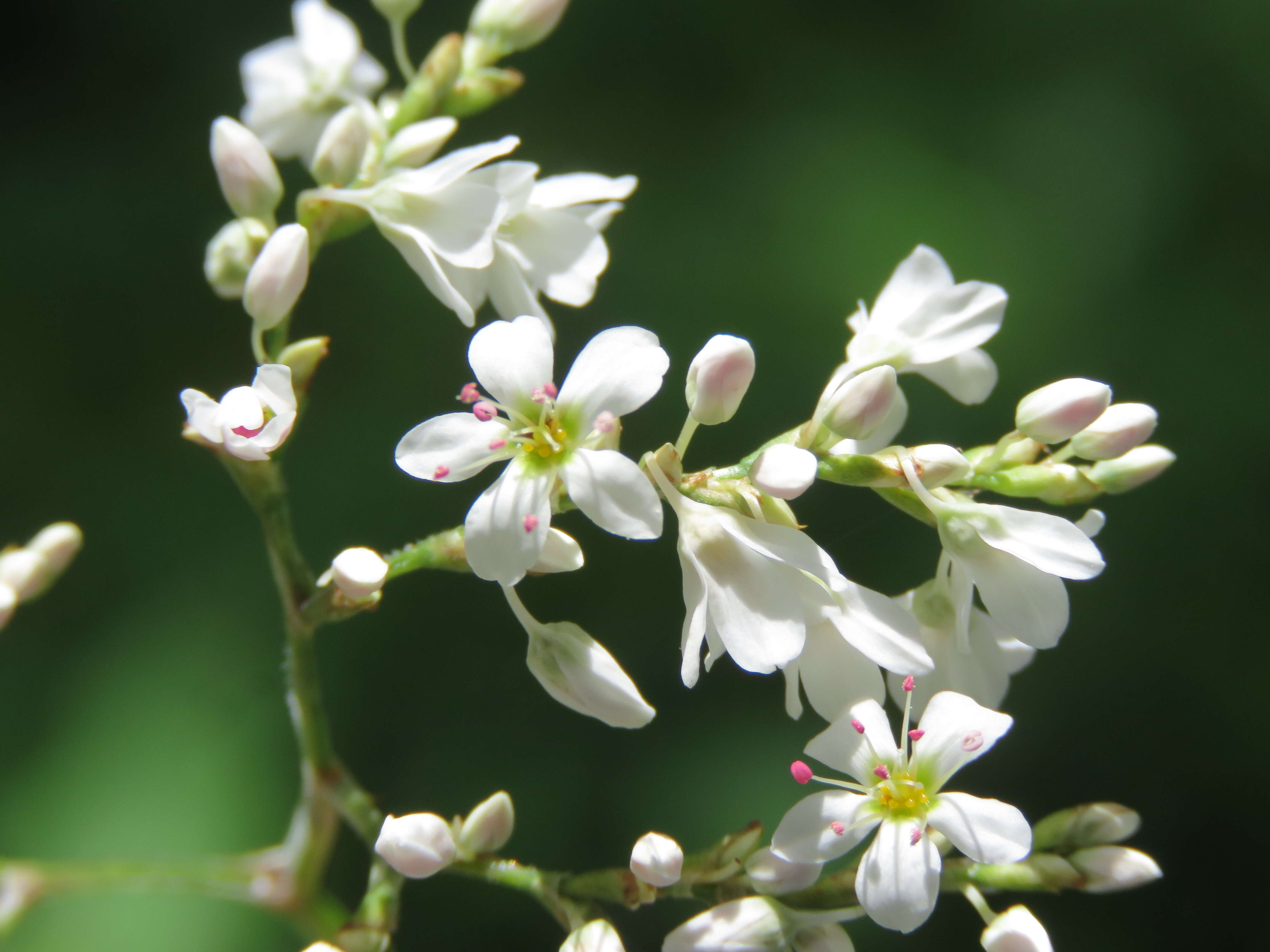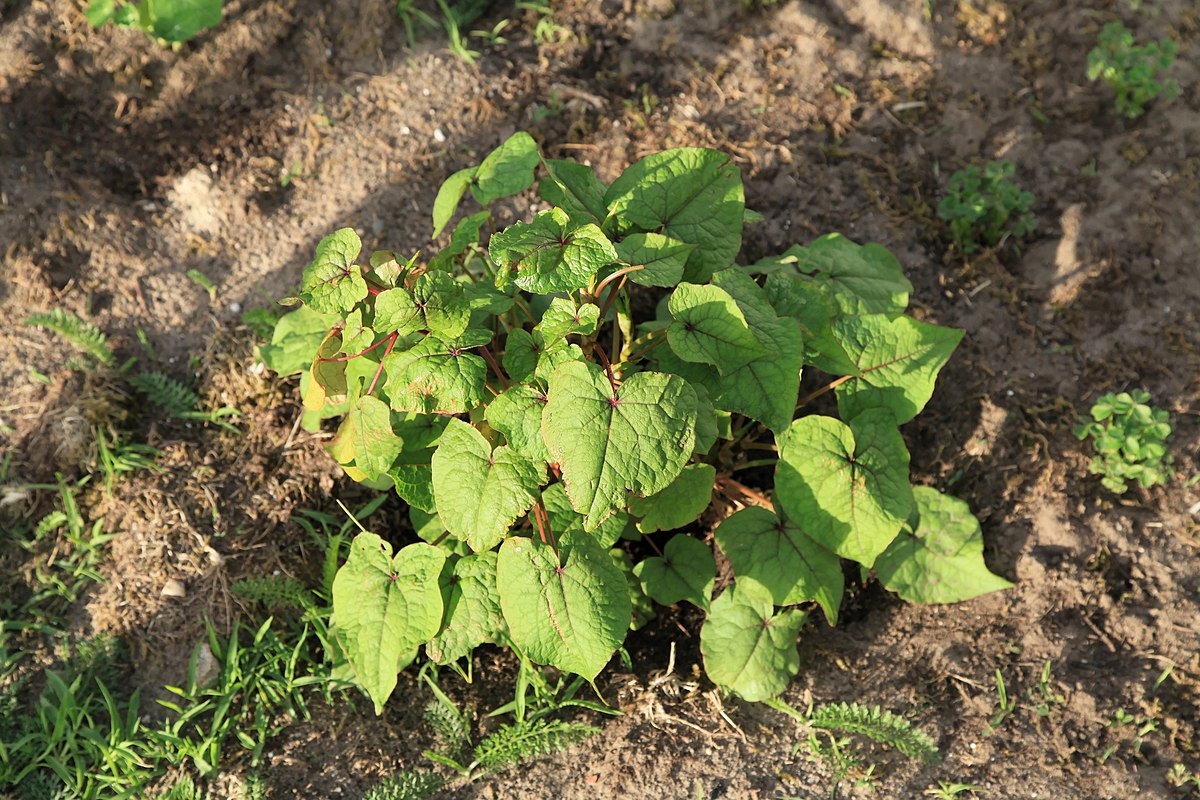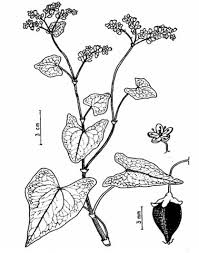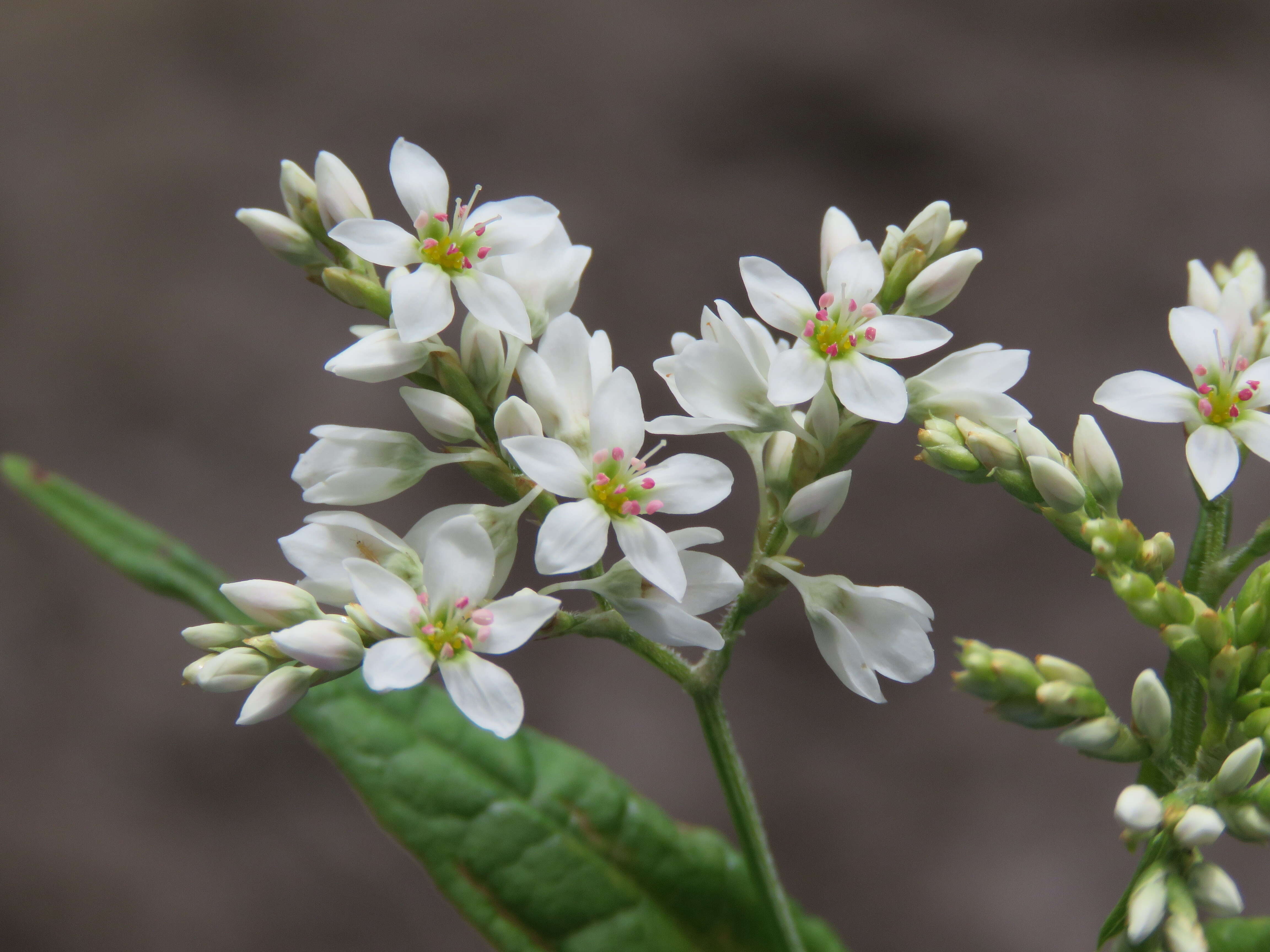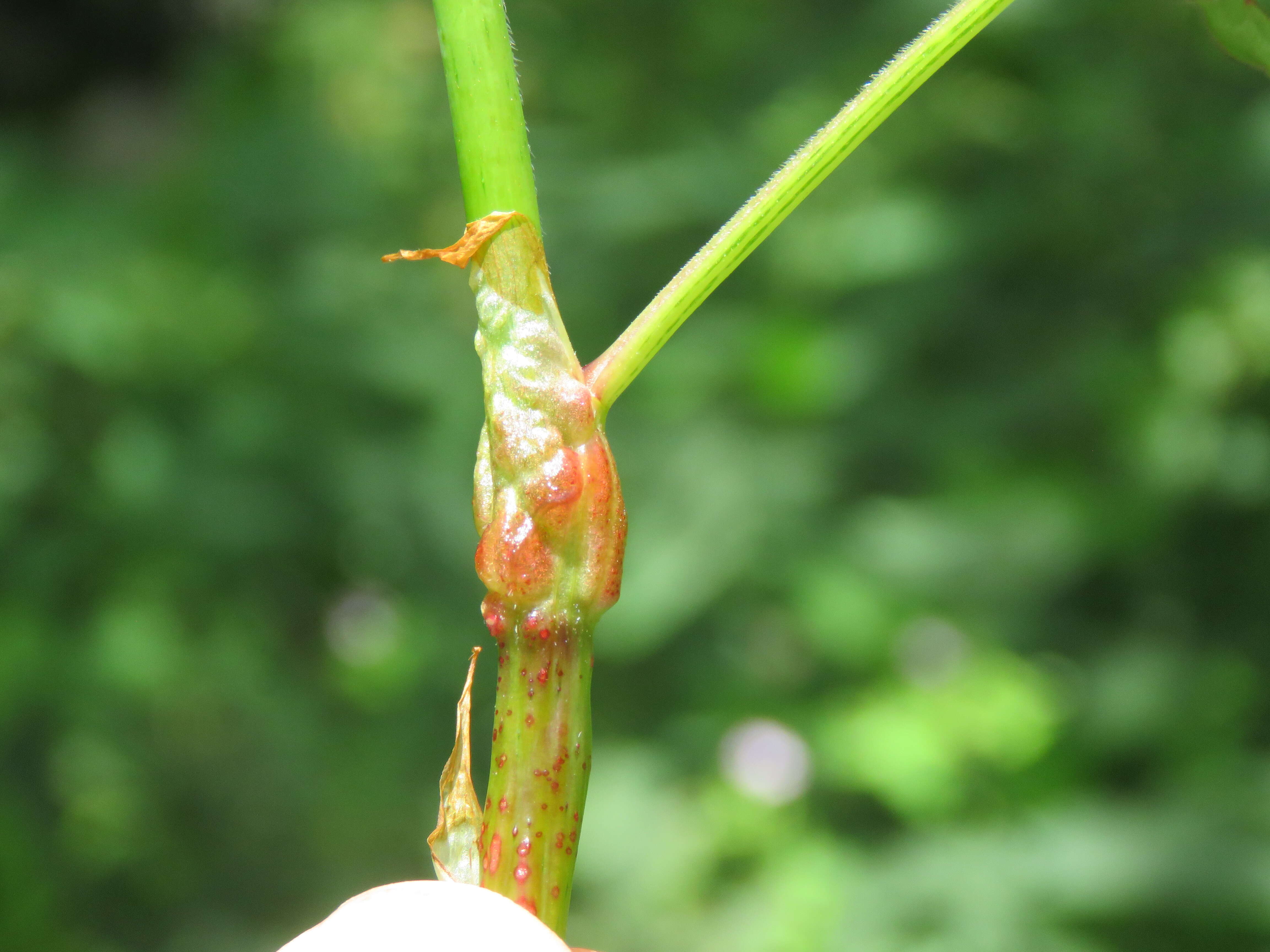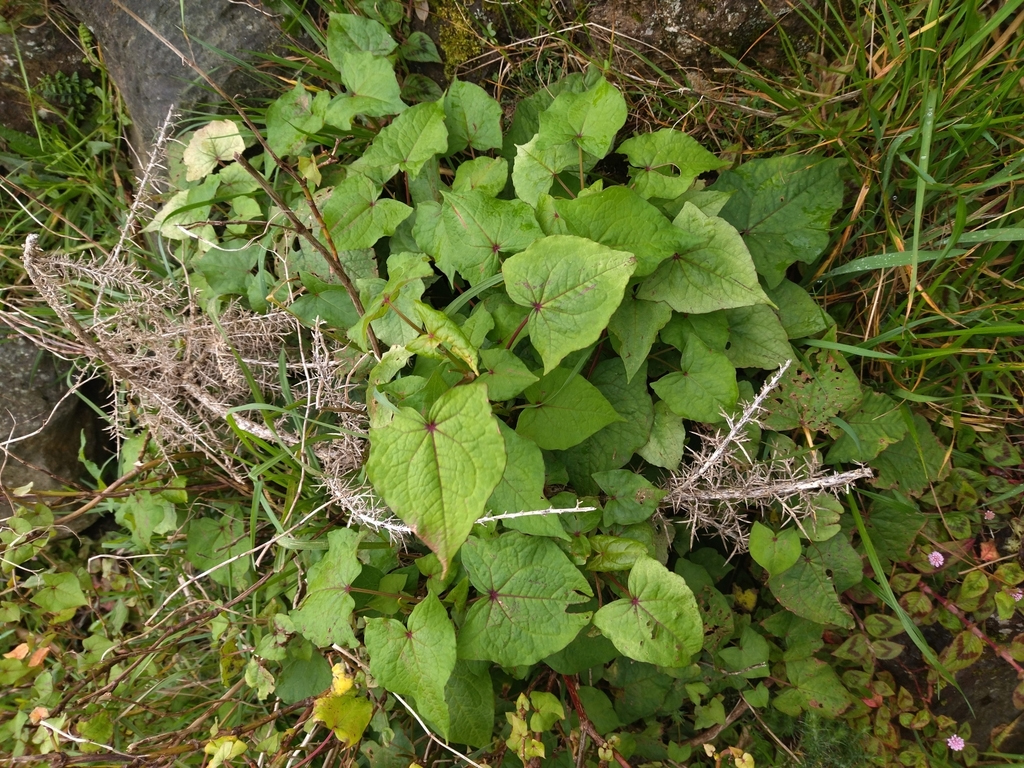The name of the genus “Fagopyrum” comes from two Latin words: “fagus” and “pyrum.” “Fagus” is Latin for “beech tree,” and “pyrum” is Latin for “pear.” The name “Fagopyrum” comes from the fact that the plant’s seeds look like pear or beech tree nuts. The word “cymosum” is a specific name that comes from the Latin word “cymosus,” which means “bearing cymes.” A cyme is a type of inflorescence in which the flower in the middle blooms first, then the flowers on the sides in a branching design. This word refers to the way the plant’s flowers are always grouped together in groups called cymes. Buckwheat seeds that are yellow are very healthy. They have a lot of complex carbs, fiber, protein, and important minerals like magnesium, manganese, and copper. Buckwheat is also full of vitamins, especially rutin, which is good for the heart and helps reduce inflammation.
Yellow buckwheat Facts
| Yellow buckwheat Quick Facts | |
|---|---|
| Name: | Yellow buckwheat |
| Scientific Name: | Fagopyrum cymosum |
| Origin | Much of China, and to Bhutan, Nepal, India, Burma, and Vietnam |
| Colors | Initially green turning to dark brown or black in color |
| Shapes | Small, dry fruits called achenes that contain a single seed |
| Taste | Slightly sweet or faintly herbal |
| Health benefits | Heart health, Allergy Relief, Enhanced Skin Health, Improved Brain Function, Mineral-rich, Weight management, Blood sugar control, Digestive healthand High in antioxidants |
| Name | Yellow buckwheat |
|---|---|
| Scientific Name | Fagopyrum cymosum |
| Native | Much of China, and to Bhutan, Nepal, India, Burma, and Vietnam |
| Common Names | Golden buckwheat, Yellow buckwheat, Golden Tartary buckwheat, Yellow Tartary buckwheat, Yellow Himalayan Buckwheat, Yellow Flowering Buckwheat, Yellow Buckwheat Wildflower, Yellow Sulphur Flower, Sulphur Buckwheat, Sulfur-flower, Umbel-stalked Buckwheat, Umbrella Plant, Wild Buckwheat, Cushion Wild Buckwheat, Buckwheat Wildflower, Western Buckwheat, Sand Buckwheat, American Buckwheat, Whorled Buckwheat, Flat-topped Buckwheat, Flat-topped Eriogonum, Flattop Buckwheat, Roundleaf Eriogonum, Umbrella Wild Buckwheat |
| Name in Other Languages | Afrikaans: Geelboekweit Arabic: Al-Hanṭah al-Ṣafra (الحنطة الصفراء) Assamese: Holodia Phapa (হলদিয়া ফাপা), Holodia Phap (হলদিয়া ফপ), Bon Choka, Bon Paleng Bengali: Hōluda tēla kṣudrabīja (হলুদ তেল ক্ষুদ্রবীজ) Bhojpuri: Pīlā Phāpar (पीला फापर), Pīlā Gahat (पीला गहत) Bulgarian: Zhalт buchim (Жълт бучим) Chinese: Huángsè qiáomài (黄色荞麦), Ye qiao mai, jīn qiáo (金荞) Czech: Žlutý pohanka Danish: Gul boghvede Dutch: Gele boekweit English: Wild buckwheat, perennial buckwheat, tall buckwheat, tree spinach, wild buckwheat Estonian: Kollane tatar Finnish: Keltainen tattari French: Sarrasin jaune German: Gelber Buchweizen, ausdauernder Buchweizen, Baumspinat, wilder Buchweizen Greek: Kítrinos achrántios (Κίτρινος αχράντιος), Kítrino achládi (Κίτρινο αχλάδι) Gujarati: Pīḷō Gōṭhāḷō (પીળો ગોઠાળો), Pīlī Kūṭhaḷī (પીળી કૂઠળી) Hindi: Pila Kutki (पीला कुटकी), ban ogal (बन ओगल) Hungarian: Sárga bogáncs Icelandic: Gulhveiti Italian: Grano saraceno giallo Japanese: Kiiroisoba (黄色いそば), Kiiro no soba (黄色のそば), himaraya-soba (ヒマラヤソバ), shakuchiri-soba, shukukon-soba (シャクチリソバ) Kannada: Haladi Godhi (ಹಳದಿ ಗೋಧಿ), Manjina Huṭṭu (ಮಂಜಿನ ಹುಟ್ಟು), Haladi Huṭṭu (ಹಳದಿ ಹುಟ್ಟು) Khasi: Jarain Konkani: Pivlo Godhi (पिवळो गोधी), Pivlo Phap (पिवळो फाप) Korean: Noran samgye (노란 삼계), Noransaek memil (노란색 메밀) Latvian: Dzeltenā griķi Lithuanian: Geltonasis grikis Maithili: Pila Phapa (पीला फापा), Pila Phapar (पीला फपर) Malayalam: Manja Gothambu (മഞ്ഞ ഗോതമ്പ്), Manja Kuttika (മഞ്ഞ കുട്ടിക്ക), Manja Kuḷḷippaṭakk (മഞ്ഞ കുള്ളിപ്പടക്ക്) Manipuri: Haladi Sola (হালদি সলা), Haladi Phap (হালদি ফাপ) Marathi: Pivla Kutki (पिवळा कुटकी), Pivla Phapar (पिवळा फापर) Nepali: Pahelo Phapar (पहेलो फापर), ban phappar (बन फापर) Norwegian: Gul bokhvete Odia: Haladia Kutki (ହଳଦିଆ କୁଟକୀ), Haladia Phap (ହଳଦିଆ ଫପ) Polish: Żółty gryka, Żółta gryka Portuguese: Trigo sarraceno amarelo, Trigo mourisco amarelo Punjabi: Pīlā Kuṭkī (ਪੀਲਾ ਕੁੱਟਕੀ), Pīlā Adangā (ਪੀਲਾ ਅਦੰਗਾ), Pīlā Adrak (ਪੀਲਾ ਅਦਰਕ) Rajsthani: Pīlā Phāfar (पीला फाफर), Pīlo Kuṭkī (पीलो कुटकी) Romanian: Hrișcă galbenă Russian: Zheltyy grechikha (Желтый гречиха) Sindhi: Pila Gotu (پيلا گٽو), Pila Phapar (پيلا فپر) Slovak: Žltý pohánka Spanish: Trigo sarraceno amarillo Swahili: Mtama mwekundu Swedish: Gul bovete Tamil: Manjaḷ Koṭumai (மஞ்சள் கோதுமை), (Manjaḷ Tēṉai (மஞ்சள் தேனை), Manjaḷ Kīrai (மஞ்சள் கீரை) Telugu: Pasupa Godhumaḷu (పసుపు గోధుమలు), Pasupu Godhuma Biyyam (పసుపు గోధుమ బియ్యం), Pasupu Āntu (పసుపు ఆంటు) Thai: Khao sam liam, Phak bung som Turkish: Sarı darı, Sarı çavdar Ukrainian: Zhovtyy grechanyy (Жовтий гречаний) Urdu: Pila Kacholi (پیلا کچولی), Pila Phapar (پیلا فپر) Vietnamese: Lúa mạch vàng |
| Plant Growth Habit | Herbaceous perennial plant |
| Growing Climates | Grasslands, open meadows, sagebrush steppe, montane environments and mountain slopes |
| Soil | Prefers well-drained soils. It can tolerate a range of soil types, including sandy or rocky soils, as long as they allow for good drainage |
| Plant Size | About 2 to 4 feet (0.6 to 1.2 meters) tall |
| Root | Possesses a taproot system, which means it has a single, dominant primary root that grows vertically into the ground |
| Stem | Erect, slender, and hollow. It grows upright from the ground and provides support to the plant’s leaves, flowers, and fruits. The stem is green when young, turning reddish-brown or purplish-brown as it matures |
| Bark | Composed of the epidermis, which is a thin, protective layer that covers the surface of the stem. It helps to prevent water loss and protect the inner tissues of the plant |
| Leaf | Typically elongated, lance-shaped, or oval. They arise from the basal rosette and can vary in size and shape depending on the variety |
| Flowering season | From June to July, although it can start as early as May or extend into August in some regions |
| Flower | Produces clusters of small, yellow flowers. These flowers are typically arranged in an umbel or cyme-like structure, with numerous flower clusters radiating from a central point. The flowers attract pollinators such as bees, butterflies, and flies, aiding in the plant’s reproductive process |
| Fruit Shape & Size | Small, dry fruits called achenes that contain a single seed |
| Fruit Color | Initially green turning to dark brown or black in color |
| Seed | small and round or triangular in shape and about 2-3 millimeters long |
| Flavor/Aroma | Slightly sweet or faintly herbal |
| Taste | Bitter, earthy, or slightly astringent |
| Plant Parts Used | Leaves, flowers, roots |
| Propagation | By seed, division, stem cutting and transplanting |
| Lifespan | 5 to 10 years or more under favorable conditions |
| Season | July to September |
| Major Nutrition |
|
| Health benefits |
|
| Available Forms |
|
| Varieties |
|
Plant Description
Yellow buckwheat is an annual plant that grows from 0.6 to 1.2 meters (2 to 4 feet) tall. The plant grows in grasslands, open plains, sagebrush steppe, montanes, and on the slopes of mountains. The plant does best in dirt that drains well. It can grow in a variety of soils, such as sandy or rocky ones, as long as they drain well. Stay away from heavy clay soils that hold too much water, as this can cause root rot. The plant could live for many years, usually between 5 and 10 years or even longer if the conditions are right. Some plants may live even longer than that, especially in places that are well-kept and good for them. Yellow buckwheat’s life span can be affected by things like temperature, soil quality, and the amount of water available.
Appropriate growing environment for Yellow buckwheat
Yellow buckwheat is adapted to a wide range of environments but generally thrives in specific growing conditions. Here are some considerations for providing an appropriate growing environment for Yellow buckwheat:
- Climate: Yellow buckwheat grows well in places that are dry or mostly dry. It can handle warm summers and cold winters. It can be found in California, Nevada, Oregon, Utah, and other western states of the United States. It is important to choose a spot that has the right weather for the plant.
- Sunlight: For yellow buckwheat to grow well, it needs a lot of direct sunshine. Choose a spot that gets full sun for most of the day, preferably for at least 6 to 8 hours. If there isn’t enough sunshine, plants may grow slowly and have fewer flowers.
- Soil: Yellow buckwheat grows best in soils that drain well. It can grow in a variety of soils, such as sandy or rocky ones, as long as they drain well. Stay away from heavy clay soils that hold too much water, as this can cause root rot.
- Watering: Yellow buckwheat can grow in dry places, but it still needs to be watered, especially when it’s getting started. Water the plant often, but don’t give it too much water because it can’t handle being soggy. Once it’s established, it can handle dry times and is pretty resistant to drought.
- Altitude: Yellow buckwheat grows at a wide range of altitudes, from the lowlands to the mountains. Different types of plants may like to grow at different heights. Talk to local botanical tools or experts to find out which varieties will grow best at your altitude.
- Maintenance: Yellow buckwheat is a plant that doesn’t need much care. Once it’s set up, it usually doesn’t need much help. But getting rid of weeds that are in the way and giving it extra water from time to time during long periods of drought can help it grow at its best.
Roots
Yellow buckwheat has a taproot, which means that it has one main root that goes straight down into the ground. The taproot is usually longer and thicker than the other roots. It is the main root that holds the plant down. From the taproot, a lot of side roots grow out and spread across the dirt. These lateral roots grow in different ways, allowing the plant to get water and nutrients from a wider area. There are many small root hairs on the side roots. These root hairs make the roots bigger, which lets them take in more water and minerals from the dirt.
It can also grow roots that aren’t connected to the main taproot system. Adventitious roots are extra roots that grow from parts of the plant that are not roots, like stems or leaves. They can give the plant more support and help it absorb more water. As the plant grows older, the taproot may slowly grow a network of flexible roots. These flexible roots are not very thick, and they form a dense mat in the top soil layers. They help the plant stay put in the ground and take in nutrients from the soil around it.
Stem
The base stands straight, is thin, and is hollow. It grows straight up from the ground and gives the plant’s leaves, flowers, and seeds something to hold on to. When the stem is young, it is green, but as it gets older, it turns dark brown or purple-brown. The stem is made up of different parts called internodes. Because these nodes are round and long, they give the stem its distinctive shape. Most of the time, the internodes are open, which lets water, nutrients, and other important things move through the plant.
Nodes are the places on a stem where leaves, branches, or other parts of the plant grow. Yellow buckwheat usually has clear nodes along its stem. These nodes are where the leaves and flowers grow from. It might grow side stems that come out of the main stem’s nodes. These stems give the plant’s leaves and flowers more support and help make it look bushy as a whole. Usually, the stem is smooth and has a few small ridges. The tiny hairs or trichomes on the skin may make it feel a little rough to the touch.
Bark
Yellow buckwheat is an herbaceous plant that doesn’t have a typical woody stem with leaves. Instead, it has a thick stem that is usually green when it is young and turns reddish-brown or purple-brown as it gets older. Because of this, its bark is not like that of trees or bushes. The epidermis is a thin, protected layer that covers the surface of the stem. It is the outermost layer of the stem. The stem’s epidermis keeps water from escaping and protects the plant’s inner cells.
Since the stem isn’t woody, it doesn’t have secondary tissues like cork and phloem, which are usually found in the bark of woody plants. These cells are what give trees and shrubs their shape and help keep them safe. Yellow buckwheat, on the other hand, has a more herbaceous stem structure, with main tissues that move water and nutrients. The xylem and phloem are two of these main tissues. The xylem moves water and minerals from the roots to the rest of the plant. The phloem moves sugars and other organic molecules around the plant.
Leaves
Most leaves are triangular or heart-shaped and end in a point. They have a wide base and a noticeable central vein that goes all the way from the base to the tip of the leaf. The leaves are alternate, which means that they are not in groups or whorls but instead are spread out along the stem. Each leaf grows from a different part of the stem, so no two leaves are right next to each other. The leaves can be small or big, but most of the time they are between 2 and 6 inches long and 5 to 15 centimeters long. The leaf surface is smooth and thin, and it feels a little bit like wax. When you touch the leaves, they might feel soft and thin.
Most of the time, the leaves are a bright, lively shade of green. But the shade of green can be different based on things like how much sunlight the plant gets and how healthy it is overall. The lines in the leaves are easy to see. The midrib is the name for the central vein that runs down the middle of the leaf from the base to the tip. Smaller veins break off from the midrib, making a complex network of veins all over the leaf. The leaf’s edge is called the leaf margin. Most leaf margins are smooth and slightly wavy, and they don’t have any big teeth or serrations.
Flower
The yellow flowers of buckwheat grow in groups called inflorescences. Most of the time, these inflorescences have a flat top or an umbel shape, and several flowers grow from a single point on a center stem. Each flower is very small, ranging between 3 and 5 millimeters across. They are shaped like a cup or bowl and have five petals and five sepals. The sepals are the flower parts that are on the outside and are usually green. Most sepals join together at the bottom to make a calyx, which looks like a cup. Before the flower opens, the calyx covers the bud as it grows.
There are five yellow flowers inside the calyx. They are usually oval or oblong in shape. The petals are the most beautiful part of the flower. Their bright colors draw in pollinators. The stamens are the parts of a flower that make male offspring. Most yellow buckwheat flowers have five stamens, and each one is made up of a thin stalk and an anther. The pollen grains that hold the male gametes are made by the anthers. The pistil is the female part of the flower that makes seeds. It is in the middle of the flower and is made up of the stigma, the style, and the ovary. The stigma is sticky and open to pollen, and the style is where the pollen tube grows. The ovary holds the ovules, which become seeds when they are fertilized. Bees, butterflies, and flies are some of the insects that pollinate flowers.
Fruits
Most of the time, the achenes are small and round or triangle in shape. They are usually flat or have a small curve. The achenes can be different sizes, but most of the time they are about 3–4 millimeters long. The wall of the fruit is called the pericarp. The pericarp is thin and dry, which makes the fruit feel like paper or leather. Most of the time, it is brown, but it can also be black or grey.
Seed
Most of the time, the seeds are small and round or triangular in shape. Compared to the size of the fruit, they are pretty big. They can be different sizes, but most are about 2-3 millimeters long. The seed coat or testa is the skin on the outside of the seed. The seed coat is usually brown or dark, and it feels tough and hard. The seed coat keeps the baby inside from getting hurt by being dropped or dried out, among other things.
Some seeds have a tissue called endosperm that is full of nutrients and feeds the baby as it grows. But in Yellow buckwheat, the endosperm is often not there or is very small. The cotyledons store the chemicals that the seed needs to germinate and grow at first.
History
Native American groups from all over the western parts of North America have used yellow buckwheat for a long time. The Shoshone, Paiute, Nez Perce, and Blackfoot, among other tribes, used different parts of the plant for a variety of things. In 1814, the German-American botanist Frederick Traugott Pursh was the first person to study yellow buckwheat and give it a name. During his study of plants in North America, Pursh came across the plant. In his book “Flora Americae Septentrionalis,” he gave a full account and classification of many North American plant species, including Yellow buckwheat.
Yellow buckwheat is still pretty common in its original range, but some populations and subspecies may be threatened by habitat loss, invasive species, climate change, and land development. Conservation efforts try to protect and keep Yellow buckwheat’s natural environments so that this important species can live on for a long time.
Varieties of Yellow buckwheat
Yellow buckwheat exhibits significant variability within its species, leading to the recognition of several varieties or subspecies. The specific number and classification of these varieties may vary depending on the botanical references consulted. Here are some of the commonly recognized varieties of Yellow buckwheat:
- Eriogonum umbellatum var. aureum: This type, which is also called “Golden buckwheat,” has flowers that are a bright golden yellow. It is native to parts of California, Nevada, and Oregon, as well as other western parts of North America.
- Eriogonum umbellatum var. furcosum: This type of buckwheat is often called “Forked buckwheat” because its leaves are deeply split, or “forked.” It lives in hilly parts of the western U.S. and can grow in a variety of soils.
- Eriogonum umbellatum var. majus: Also called Large-flowered buckwheat, this type of Yellow buckwheat has flowers that are bigger than those of other types. Parts of California, Idaho, Nevada, Oregon, and Utah are where it comes from.
- Eriogonum umbellatum var. polyanthum: This type of buckwheat is called “Many-Flowered Buckwheat” because it has a lot of flower groups on each stem. It lives in many western states, like California, Idaho, Nevada, Oregon, and Washington.
- Eriogonum umbellatum var. subalpinum: Subalpine buckwheat is a type that grows in high-elevation areas, like the Rocky Mountains’ subalpine and alpine settings. It lives in places like Montana, Colorado, and Wyoming, where the weather is colder.
- Eriogonum umbellatum var. subarcticum: This type of buckwheat, which is also called “Sub-arctic buckwheat,” grows in Alaska, Canada, and the northern Rocky Mountains, where the elevation is high. It is used to living in subalpine and alpine areas, where it is cold and the growing season is short. The flowers and leaves of subarctic buckwheat are usually smaller than those of other types.
- Eriogonum umbellatum var. polycladon: Polyhedral buckwheat is a type with leaves that are shaped like polygons. It is native to parts of California, Nevada, and Utah in the western United States. Polyhedral buckwheat usually grows in rocky, desert-like places, where it grows low and spreads out.
- Eriogonum umbellatum var. corymbosum: Corymbose buckwheat is a type that is known for its tight clusters of flowers that are grouped in corymbs, which are inflorescences with flat or rounded tops. It can be found in California, Nevada, Oregon, Idaho, and other western states. Corymbose buckwheat grows best in sunny places with dirt that drains well.
- Eriogonum umbellatum var. ellipticum: Buckwheat with elliptical-shaped leaves has leaves that are long and narrow. Some parts of California, Oregon, and Washington are where it comes from. Buckwheat with elliptical leaves usually grows in meadows, open forests, and rocky slopes, where it grows in groups.
- Eriogonum umbellatum var. nevadense: Nevadan buckwheat is a type that grows mostly in Nevada and the areas around it. It grows low and spreads out, which helps it survive in dry, rocky places. Nevadan buckwheat has groups of yellow flowers, but the color of those flowers can change depending on where it grows.
- Eriogonum umbellatum var. bifurcatum: This type of buckwheat is also called “Forked buckwheat” because its leaves are deeply split, or “forked.” It lives mostly in the Great Basin area of the western United States, which includes parts of Nevada, Utah, and Idaho. Forked buckwheat tends to grow in dry, rocky places and spreads out as it grows.
- Eriogonum umbellatum var. mogollonicum: Mogollon buckwheat is a variety endemic to the Mogollon Rim region of Arizona and New Mexico. It thrives in rocky and high-elevation habitats, often occurring in coniferous forests. Mogollon buckwheat features clusters of yellow flowers and can display variations in flower color.
- Eriogonum umbellatum var. pubescens: Pubescent buckwheat has leaves and stems that are very hairy, or pubescent. It can be found in California, Oregon, Nevada, Idaho, and other western states. Most of the time, pubescent buckwheat grows in rocky or sandy places, like mountains and slopes.
- Eriogonum umbellatum var. ramulosum: Ramose buckwheat is a type that has many shoots that branch out, making it looks bushy. It comes from parts of California and Oregon, where it lives mostly in dry, rocky places. Ramose buckwheat grows in clumps and has yellow flowers. It spreads out as it grows.
- Eriogonum umbellatum var. scopulorum: Scopulorum is a type of buckwheat that grows in the Rocky Mountains, especially in Colorado, Wyoming, and Montana. It is used to living in high-altitude, mountain areas, where it often grows in rocky or gravelly soil. Scopulorum buckwheat grows low and matts together. It has clumps of yellow flowers.
- Eriogonum umbellatum var. aurantiacum: Aurantiacum buckwheat, which is also called “Orange-Flowered buckwheat,” is known for its bright orange flowers. It lives mostly in the western part of the United States, in places like California, Nevada, and Oregon. Aurantiacum buckwheat grows best in soils that drain well and can be found in places like fields, slopes, and open woods.
- Eriogonum umbellatum var. munroi: Munro’s buckwheat is a type that was named after the scientist Munro, who was known for his work on California’s plants. It grows naturally in the southern Sierra Nevada and southern Cascades in California. Munro’s buckwheat usually grows in open, rocky places and has clusters of yellow flowers.
- Eriogonum umbellatum var. rubescens: Rubescent buckwheat is easy to spot because its flowers and leaves are reddish or pinkish. It can be found in California, Nevada, Oregon, and Washington, among other western states. Rubescent buckwheat can grow in a wide variety of places, from sandy soils to rocky hills. It is known for attracting pollinators.
- Eriogonum umbellatum var. munzii: Munz’s buckwheat, also called Munz’s golden buckwheat, is a type of buckwheat that grows only in California. It is named after the scientist Philip A. Munz and is mostly found in the Transverse Ranges and the San Gabriel Mountains. Munz’s buckwheat usually grows in dry, rocky places, and its growth is thick and pillow-like.
- Eriogonum umbellatum var. tenue: Tenue buckwheat is a type that has thin stems and a delicate look. It is native to parts of California, Nevada, and Utah in the western United States. Tenue buckwheat usually grows on dry, rocky hills. Its flowers can be yellow, cream, or white.
Health benefits of yellow buckwheat
Yellow buckwheat, also known as Fagopyrum tataricum, is a nutritious grain-like seed that offers several health benefits. It is a gluten-free pseudo-cereal and a rich source of various essential nutrients. Here are some of the detailed health benefits of yellow buckwheat:
1. Nutrient-rich
Yellow buckwheat is a food that is full of vitamins, minerals, and enzymes that your body needs. It has nutrients like magnesium, manganese, phosphorus, zinc, and copper, as well as vitamins B1 (thiamine), B2 (riboflavin), B3 (niacin), B5 (pantothenic acid), B6, and foliate.
2. High in antioxidants
Yellow buckwheat has a lot of flavonoids and phenolic substances, which are antioxidants. Antioxidants help protect the body from oxidative stress, which can damage cells and lead to long-term illnesses like heart disease, cancer, and neurodegenerative disorders.
3. Heart health
Yellow buckwheat has a vitamin called rutin, which may help keep the heart healthy. Rutin makes blood vessels stronger, improves blood flow, and lowers the risk of heart diseases like high blood pressure and cholesterol. Buckwheat also has a lot of fiber, which may help control cholesterol levels and support a healthy heart.
4. Blood sugar control
Yellow buckwheat has a low glycemic index. This means that it raises blood sugar levels more slowly than foods with a high glycemic index. This makes it good for people with diabetes or who want to keep their blood sugar levels in check. Buckwheat has a chemical called chiro-inositol, which may also help the body use glucose better.
5. Digestive health
Yellow buckwheat has a lot of fibre, which helps the digestive system. Fiber adds bulk to poop, which keeps you from getting constipated, and helps good gut bugs grow. It can also help control bowel processes and improve the health of the digestive system as a whole.
6. Weight management
Yellow buckwheat is a filling and healthy foods that can help you lose weight. Fiber helps control hunger by making you feel full and stopping you from eating too much. Also, the complex carbohydrates in buckwheat give you energy that lasts, so you feel full for longer.
7. Gluten-free alternative
Yellow buckwheat is naturally free of gluten, which makes it a good grain replacement for people who are sensitive to gluten or have celiac disease. It can be used in gluten-free recipes for things like bread, pancakes, and pasta. It is a healthy option to traditional grains that contain gluten.
8. Anti-inflammatory properties
9. of the chemicals in yellow buckwheat, like quercetin and other flavonoids, can help reduce inflammation. These qualities might help lower inflammation in the body, which is linked to a number of long-term conditions like arthritis, heart disease, and some types of cancer.
9. Nutritional support for vegetarians and vegans
Yellow buckwheat is a great source of plant-based proteins, which makes it an important part of a vegetarian or vegan diet. It is a complete source of protein because it has all nine necessary amino acids.
10. Mineral-rich
Yellow buckwheat is a good source of magnesium, phosphorus, and potassium, which are all important minerals. These minerals are important for bone health, nerve function, and keeping the right mix of electrolytes in the body.
11. Improved Brain Function
Buckwheat has nutrients that are good for the brain. Vitamin B1 helps the brain make hormones, which helps the brain work well. Also, rutin, which is found in buckwheat, has been linked to better brain function and a lower chance of neurodegenerative diseases.
12. Enhanced Skin Health
Yellow buckwheat has vitamins like rutin and quercetin that help keep the skin healthy. They protect against reactive stress, slow the signs of ageing, and make skin more flexible. Buckwheat can help keep your skin healthy and looking young if you eat it.
13. Allergy Relief
Some studies show that buckwheat may help relieve allergy symptoms by having chemicals in it. Histamine, a chemical that is involved in allergic responses, can’t get out of cells when these compounds are present. Because of this, eating buckwheat may help with allergy symptoms like sneezing, itching, and stuffy nose.
Different medicinal forms of Yellow buckwheat
Yellow buckwheat is not commonly used in modern medicine; there are different forms in which Yellow buckwheat could potentially be used medicinally. Here are some examples:
- Infusions or Teas: Yellow buckwheat can be used to make teas or liquids from its leaves or flowers. For their possible medicinal benefits, these infusions or teas can be taken by mouth.
- Topical Preparations: Yellow buckwheat can be put on the skin in many different ways. You can put leaves or flowers in oils or mix them with other things to make ointments, salves, or poultices. You can put these preparations on your face to treat certain conditions or feel better.
- Tinctures: Tinctures can also be made from buckwheat that is yellow. Tinctures can be taken by mouth, usually in small amounts, to help with health problems.
- Decoctions: Yellow buckwheat can be made into a decoction by cooking the plant parts, like the roots or leaves, for a long time in water. The juice that comes out can be drunk or put on the skin.
- Compresses: Compresses can be made from yellow buckwheat. People often use compresses to reduce swelling, soothe skin conditions, or ease muscle pain.
- Herbal Baths: Yellow buckwheat can be used to help people feel better in plant baths. Herbal infusion made from leaves or flowers is added to bathwater so that the skin can absorb the healthy chemicals.
- Poultices: Poultices can be made from yellow buckwheat. The paste is then put directly on the skin to treat things like bug bites, small cuts, and skin irritations.
- Salves or Balms: You can make salves or balms with yellow buckwheat. Most salves are made by putting leaves or flowers in a carrier oil and adding beeswax or something else to make it rigid. This makes an ointment that can be put on small cuts, burns, or skin irritations to help them feel better.
- Inhalations: Yellow buckwheat can be used to make medicines that are breathed in. Inhalations are often used to help with breathing problems or to clear up stuffy noses.
- Capsules or Tablets: Yellow buckwheat extracts or powders can be put into capsules or pressed into pills so that they are easy to take by mouth. This makes it possible to give a consistent dose and easy to add to a daily routine.
Culinary Uses of Yellow buckwheat
Yellow buckwheat, also known as yellow buckwheat flour or yellow buckwheat groats, is a versatile ingredient that can be used in various culinary preparations. Here are some culinary uses of yellow buckwheat:
- Pancakes: Yellow buckwheat flour can be used to make pancakes that are both tasty and good for you. Mix together yellows buckwheat flour, baking powder, salt, milk, eggs, and your pick of sweetener. On a grill or in a pan, cook the pancakes until they are golden brown. Serve for breakfast or lunch with maple syrup, honey, or your other favorite toppings.
- Buckwheat Bread: Gluten-free bread can be made with yellow buckwheat flour. Mix yellow buckwheat flour with other gluten-free flours like tapioca flour or almond flour, yeast, water, salt, and a glue like xanthan gum or psyllium husk. Make the dough into a ball, let it rise, and bake it until it’s golden. You can make a sandwich with gluten-free buckwheat bread or toast it to make a tasty side dish for soups or salads.
- Noodles and Pasta: Noodles and pasta can be made with yellow buckwheat flour. Buckwheat noodles are a popular choice in many cuisines because they have a unique taste and color.
- Crepes: Pancake recipes often call for yellow buckwheat flour. Crepes made with buckwheat have a rich flavor and are often eaten with sweet or savory toppings.
- Crackers: Gluten-free crackers can be made with yellow buckwheat flour. The flour gives the food a special flavor, and it can be mixed with other ingredients, like herbs, spices, or seeds, to make the flavor even better.
- Porridge: Yellow buckwheat groats that have been cooked can be used to make a filling, healthy porridge. Rinse the buckwheat groats and cook them in water or milk until they are soft and the liquid has been consumed. Add honey, maple syrup, or sugar to make it sweet, and spices like cinnamon or vanilla to make it taste good. For a warm and healthy breakfast, add fruits, nuts, or seeds on top.
- Salads: Yellow buckwheat groats add a nutty and chewy feel to salads. They can be cooked and let cool before being added to salads with veggies, dressings, and other things.
- Buckwheat Pilaf: Yellow buckwheat groats that have been cooked and seasoned can be used as the base for tasty rice. In a pan, sauté onions, garlic, and any veggies you want. Add cooked buckwheat groats and either chicken or veggie broth. Simmer the food until the flavors blend and the liquid is soaked up. You can make a delicious side dish by adding herbs, spices, or other things like dried fruits or nuts.
- Garnish: Yellow buckwheat groats that have been toasted can be used to top soups, stews, and salads. They add crunch and a nutty flavor that goes well with many recipes.
- Buckwheat Flour Tortillas: Gluten-free tacos can be made with yellow buckwheat flour. Mix together yellows buckwheat flour, water, oil, a pinch of salt, and other gluten-free flours like tapioca flour or rice flour. Roll out the dough and cook the tortillas on a griddle or in a pan. These tortillas are great for wrapping up everything from veggies and beans to meats and cheeses.
- Buckwheat Granola: Yellow buckwheat groats can be incorporated into homemade granola for added crunch and texture. Combine buckwheat groats with rolled oats, nuts, seeds, and dried fruits, sweeteners like honey or maple syrup, and flavorings such as cinnamon or vanilla. Bake the mixture until golden and crispy. Enjoy the granola with yogurt, milk, or as a topping for desserts.
- Buckwheat Cookies: Cookies that don’t have gluten can be made with yellow buckwheat flour. Mix yellow buckwheat flour with other gluten-free flours, like almond flour or rice flour, butter, sugar, eggs, and flavorings like chocolate chips or dried fruits. Make cookies out of the dough and bake them until they are golden brown. These cookies taste like nuts and are a little bit crumbly.
- Buckwheat Muffins: Gluten-free muffins can be made with yellow buckwheat flour. Add yellow buckwheat flour, baking powder, sugar, eggs, oil, and milk to other gluten-free flours like tapioca flour or oat flour. Add whatever flavors you like, like fruits, nuts, or spices. Put the batter in muffin tins and bake them until they are done. These muffins are a healthy and filling choice for breakfast or a snack.
- Buckwheat Pancake Mix: When mixed with other dry ingredients, yellow buckwheat flour can be used to make pancake mix at home. Mix together yellows buckwheat flour, all-purpose flour, baking powder, sugar, and a pinch of salt. Put the mix in a jar that won’t let air in and use it later. When you’re ready to make pancakes, just add eggs, milk, and oil to the mix and cook as usual. This pancake mix is a handy and healthy way to start the day.
- Buckwheat Soba Noodles: Soba noodles, which are a popular dish in Japan, are often made with yellow buckwheat flour. To make dough, mix yellow buckwheat flour with wheat flour, water, and salt. Roll out the dough and cut thin noodles from it. The noodles should be cooked in hot water until they are soft, then rinsed in cold water. Soba noodles can be eaten hot or cold and they are usually served in soups or with dipping sauces.
- Buckwheat Risotto: Yellow buckwheat groats can be used in risotto recipes instead of gluten-based grains. Cook the buckwheat groats with onions and garlic in chicken or veggie broth. While stirring, slowly add the water until the groats are soft and creamy. Add grated cheese, herbs, and spices of your choice to the rice to finish it off. This buckwheat risotto has a lot of flavor and fills you up.
- Buckwheat Pudding: Yellow buckwheat groats can be used to make custard that is both creamy and good for you. Cook the buckwheat groats in milk or a milk substitute with sweeteners like honey or maple syrup and flavors like vanilla or cinnamon. Let the mixture cook until the groats are soft and the liquid has thickened. You can serve the custard hot or cold, with fruits or nuts on top.
- Buckwheat Stuffed Vegetables: Yellow groats of buckwheat can be used to stuff veggies. Cook the buckwheat groats and mix them with sautéed veggies, herbs, spices, and, if you want, cooked ground meat or cheese. Stuff the mixture into bell peppers, zucchinis, or tomatoes and bake until the veggies are soft and the filling is cooked all the way through. This dish is a hearty and tasty main meal that can be made with or without meat.
- Buckwheat Pilaf Salad: Yellow buckwheat groats that have been cooked can be used as the base for a healthy rice salad. Let the cooked groats cool, and then toss them with chopped cucumbers, tomatoes, bell peppers, and herbs like parsley or mint. Drizzle with a dressing made of lemon juice, olive oil, and spices. This salad can be a light meal or a side dish for meats or fish that have been grilled.
- Buckwheat Waffles: Yellow buckwheat flour is also great for making waffles that are both crisp and fluffy. Mix together yellow buckwheat flour, baking powder, salt, milk, eggs, and a little bit of sugar. Use a waffle pan to cook the batter until it is golden and crisp. For a tasty breakfast treat, add fresh fruit, whipped cream, or syrup on top.
- Buckwheat Stir-Fry: Yellow buckwheat groats that have been cooked can be added to a tasty stir-fry dish. You can sauté whatever veggies and proteins you want, like broccoli, carrots, mushrooms, and snap peas, as well as chicken, tofu, or shrimp. Stir-fry the cooked buckwheat groats until everything is cooked through and mixed well. For a healthy and tasty meal, add soy sauce, ginger, garlic, or any other spices you like.
- Buckwheat Tabouli: Yellow buckwheat groats can be used instead of wheat berries in tabouli, a traditional Middle Eastern meal, to make it gluten-free. Cook the groats, then let them cool down. Mix them with herbs like mint or cilantro and carefully chopped fresh parsley, tomatoes, cucumbers, and onions. For a light and delicious salad, dress the tabouli with lemon juice, olive oil, salt, and pepper.
- Buckwheat Stuffing: Gluten-free stuffing can be made with yellow buckwheat groats. In a pan, sauté onions, celery, and herbs. Mix in the cooked buckwheat groats and either chicken or veggie broth. Put the mixture in a baking dish and bake it until the top is golden and crisp. Serve with roasted meats or as a stuffing choice for vegetarians.
- Buckwheat Desserts: Several dessert recipes call for yellow buckwheat flour or cooked buckwheat groats. You can make cookies, muffins, cakes, and even puddings out of buckwheat. Try out different mixtures of ingredients, like chocolate, fruits, nuts, spices, and herbs, to make sweet treats that are unique and tasty.
Different uses
Yellow buckwheat is a cereal crop that is primarily grown for its edible seeds. It is a member of the buckwheat family and has several uses in various industries. Here are some of the different uses of yellow buckwheat in detail:
- Animal Feed: Yellow buckwheat is often used to feed chickens, pigs, and horses, among other animals. It gives you energy and important nutrients, especially protein, fiber, and vitamins. When the seeds are picked, the straw that is left over can be used as animal bedding or food.
- Cover Crop and Green Manure: Yellow buckwheat is used as a cover crop or green manure by farmers and gardeners to improve the soil and keep weeds from growing. As a cover crop, its fast growth and dense foliage help smother weeds and stop them from competing with other products. Buckwheat also has deep roots that help break up hardened soil and improve its structure. This makes it easier for water to get into the soil and nutrients to be used. Once the plants are fully grown, they can be tilled back into the earth, where they will add nutrients and organic matter.
- Bee Forage: Bees and other pollinators are drawn to the yellow flowers of buckwheat. They make a lot of nectar, which makes them a good plant for making honey. Beekeepers often grow buckwheat near their hives so that bees can get nectar from it when there isn’t much nectar from other flowers. Buckwheat honey has a flavor all its own, and some people like it for that reason.
- Soil Erosion Control: Yellow buckwheat is sometimes used to stop soil loss because it grows quickly and has dense leaves. Its large root system helps hold the earth together; making it less likely that wind or water will wash away the soil. Buckwheat can be planted to stabilize the soil on slopes, building sites, and other places where it is likely to wash away until permanent plants grow there.
- Brewing: Yellow buckwheat can be used to make beer and other alcoholic beverages. It’s often processed and used as a specialty grain to give craft beers their own tastes and colors. Buckwheat gives beer a distinct earthy and nutty taste, which is why it is often used to make gluten-free beer.
- Soil Improvement: Yellow buckwheat is known for its ability to improve soil health, in addition to its use as a cover crop and green manure. Its deep root system helps break up hardened soil, making it easier for water to drain and air to circulate. The roots also release organic acids that can make it easier for nutrients to get into the soil. This makes the soil more fertile generally.
- Biomass and Biofuel: Biomass can be made from yellow buckwheat that has been grown. Buckwheat could be used to make biofuel because it grows quickly and makes a lot of biomass. Plant waste like stalks and leaves can be burned or put through anaerobic digestion to make biofuels or biogas, or they can be used as a source of green energy.
- Ornamental Plant: Yellow buckwheat can be used as a decorative plant in parks and other outdoor spaces. It has pretty white flowers that turn different shades of pink as they age, which add beauty to fields. The plant’s broad leaves and bushy growth make it a good choice for borders, fences, or as a background for other flowering plants.
- Environmental Remediation: Yellow buckwheat has been looked at to see if it could be used in phytoremediation, which is when plants are used to get rid of or lessen the effects of pollution in the environment. Buckwheat has been shown to take in heavy metals like lead and cadmium from grounds that are contaminated. It can help clean up polluted dirt in places like industrial sites, mining areas, and other places.
- Traditional Crafts and Materials: Yellow buckwheat straw is used in some countries to make crafts and other things. Straw can be made into baskets, hats, mats, and other useful things. It has also been used to stuff pillows and seats because it is naturally strong and lets air pass through.
- Soil Amendment and Composting: Yellow buckwheat waste like stalks, leaves, and roots can be added to compost or used to improve the soil. As these organic materials break down, they add to the organic matter in the soil. This improves the soil’s structure, ability to hold water, and mineral content. Adding leftover buckwheat to compost piles can speed up the process of decomposition and make nutrient-rich waste for gardening and farming.
- Dyeing and Natural Pigments: Flowers can be used to get dyes and colors from nature. The flowers have colors that can be used to dye fabrics, yarns, or natural fibers different shades of yellow, from light to bright. Buckwheat flower dyes are often used by artists and craftspeople to make unique and eco-friendly color schemes.
- Wildlife and Biodiversity Support: Yellow buckwheat helps wildlife and different kinds of life. Beneficial animals, like butterflies, bees, and other pollinators, use the plant for food and shelter. In turn, these insects help pollinate other plant species, which is good for the health and diversity of the environment as a whole.
- Herbal and Nutritional Supplements: Yellow buckwheat is sometimes used to make herbal medicines and foods that are good for your health. Buckwheat extracts made from its flowers, leaves, or seeds are used because they may be good for your health. Bioactive substances like antioxidants and flavonoids, which are thought to be good for human health, may be in these supplements.
Side effects of Yellow buckwheat
Buckwheat is generally considered safe for consumption, and side effects are rare. However, in some cases, individuals may experience certain reactions or side effects, which can include:
- Allergic Reactions: Buckwheat could make some people sick if they are allergic to it. An allergic response can cause symptoms like itching, hives, swelling, trouble breathing, or stomach pain. If you know you are allergic to other grains or seeds, you should be careful when eating buckwheat.
- Digestive Issues: Buckwheat has some chemicals in it that can be hard for some people to stomach. This can cause signs like bloating, gas, stomach pain, or changes in the way you go to the toilet. If you have a sensitive digestive system or a history of stomach problems, you should eat buckwheat in small amounts and see how your body responds.
- Oxalate Content: Oxalates are natural chemicals that are found in buckwheat and many other plant foods. People who are more likely to get kidney stones or who already have kidney problems could get more of them if they eat foods high in oxalates. Before adding buckwheat to their diet, people with these conditions should talk to a doctor or other health worker.
- Medication Interactions: Buckwheat may affect how some medicines work. If you are taking blood thinners or anticoagulants, it is best to talk to your doctor before taking buckwheat or supplements made from buckwheat to make sure there are no possible reactions.
- Potential Thyroid Interference: Buckwheat has chemicals in it called goitrogens that, in large amounts, can stop the thyroid from working. These chemicals can stop the body from taking in iodine, which could affect the production of thyroid hormones. But buckwheat’s goitrogenic effects are usually small and may not be a problem if it is eaten as part of a healthy diet. Before eating a lot of buckwheat, people with thyroid problems or low iodine levels should talk to a doctor.
References:
http://www.theplantlist.org/tpl1.1/record/kew-2807293
https://gd.eppo.int/taxon/FAGCY
https://en.wikipedia.org/wiki/Fagopyrum_cymosum
https://indiabiodiversity.org/species/show/251880


